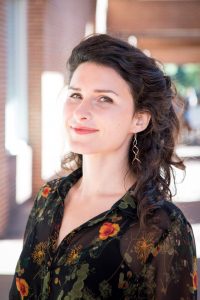Sarah Morris, humanities research librarian
Since the campus first closed, humanities research librarian Sarah Morris has been connecting with faculty and students remotely. In May, campus publication The Well asked Morris about her transition to working at home. We asked Morris for an update.

Sarah Morris, Humanities Research and Digital Instruction Librarian, Research and Instructional Services
How has your work changed since the springtime?
One of the things I love about my job is that it changes with the seasons. The pandemic hit in the second half of spring semester, so there was an immediate scramble for electronic resources, for translating assignments and research over to new or digital mediums. Over the summer I was able to consult with faculty more individually, planning assignments and resources for their courses and practicing new ways of teaching. Since fall began it’s been a teaching and consultation marathon, which I love most. A happy surprise is that this kind of seasonal workflow translates over, even when working remotely.
Have you developed new habits, practices or skills?
I’ve thought a lot more about accessibility than I used to—the pandemic has shown us that we can’t assume that everyone can access our materials in the same way! Some students may not have consistent wi-fi, or may be in a different country, or may need accommodations for web-based content. Thinking about these things has impacted the kinds of resources I design, the kinds of materials I purchase.
With all that has happened, I am thinner-skinned and more grateful for connection. So, in meetings with students I do try to connect with them personally, give them a little space to tell me about their day or their class or show me their cat. I’m more open to a little meandering than I used to be, and I think it makes me a better librarian, certainly a happier one!
What is it like to teach a class by Zoom?
At first, I really didn’t like it; it felt like talking to a void box of names. But my colleagues have shared some great tips and I’ve come to really like it! I try to make a simultaneous notes-space that we can all write in at the same time, so that even if students aren’t talking, they can be interacting. I also use lots of break-out rooms and try to incorporate as much group work and problem-based work as possible. Anything to minimize the time I’m yammering on and maximize their critical thinking. Our students are so smart and are willing to engage if there’s space to do so.
Are people coming to you with different needs or different types of questions than in a typical year?
I work with the humanities, so in a beautiful way, many questions are variants of the same ones people have been asking for a long time. Meaningfully, I’ve had more questions related to technology and our lives. I’ve worked with some health humanities students who are interested in the impact of COVID-19 on the arts, on balms to isolation and depression, on the value and limitations of virtual reality. Some of my honors thesis students are interested in collective grief and virtual mourning spaces for victims of racial violence. I watch the questions people live melt into the questions of their classes, and I get to help them think through these things that affect all of us.
Is there anything that you’ve learned or started doing during this time that you will continue post-pandemic?
I will always make remote consultations an option! Students seem less intimidated to schedule a Zoom appointment than appear in my office, and we can do the same work this way. I also try to take a midday walk every day and look forward to doing that in the beautiful arboretum when it’s safe again.
This story originally appeared in the fall/winter 2020 issue of Windows, the magazine of the Friends of the Library at the University Libraries.
Return to Windows fall/winter 2020 stories

